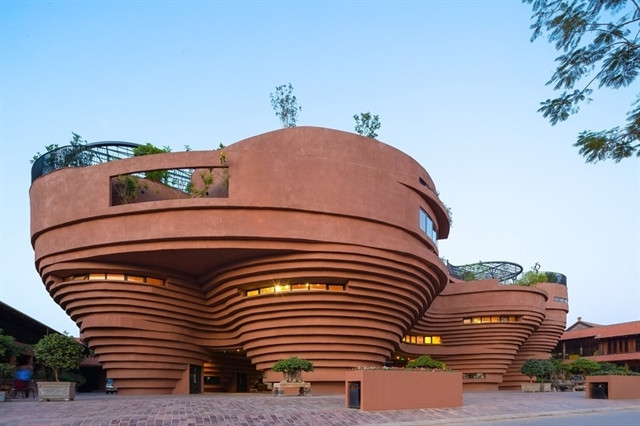 |
| Bát Tràng Gốm Museum is one of the must-see places in Bát Tràng Village. — Photo baovanhoa.vn |
Attending the seminar held by the Centre of Vietnamese Quintessential Craft Villages, over seventy experts in the fields of culture, architecture, art and museums, along with leaders of departments and branches of Hà Nội City and professsionals from the Bát Tràng ceramic village and artisans, met to discuss the issue.
Located on the left bank of the Red River and about 13km to the southeast of the capital city, Bát Tràng Village has become one of the country’s most popular traditional craft villages and a famed tourist destination, renowned for its ceramic and porcelain products.
"Bát Tràng meets all the criteria for an ecomuseum," said expert Nguyễn Thị Thu Trang. "In this model, the Bát Tràng Village community is a cultural asset, the owner of the cultural heritage and also the organiser and operator of the Bát Tràng Ecomuseum."
It will be non-state owned museum, but it will be managed by the local authority, under legal guidelines, while experts will fulfill the roles of professional consultants, Trang added.
One of the things that will need to be addressed when creating the Bát Tràng Ecomuseum is how the Heritage Law will need to be adjusted, according to Nguyễn Thị Thu Phương, head of Việt Nam National Institute of Culture and Art Studies.
Phương said that it is necessary to strengthen and promote Hà Nội's creative spaces, but also it needs to unite the Government, managers, businesses and village communities.
Bát Tràng Village is not just known for its traditional ceramic products, its culture and history are featured in architectural works, festivals and unique culinary art.
The village traditional craft was recognised as national non-intangible cultural heritage asset in 2022 and it was on Hà Nội's list of best tourism spots in 2019.
The seminar participants also discussed on how to futher develop Bát Tràng's traditional craft village while preserving local cultural identity and protecting the local ecology, land and people, with a view to enhancing local social-economic development.
Villager and artisan Tô Thanh Sơn agreed and welcomed the plans for a Bát Tràng Ecomuseum. "I just think about how it will begin. On behalf of the villagers we are ready to co-operate with the relevant bodies to carry out the project," Sơn said at the seminar.
Professor Lê Hồng Lý, president of Việt Nam Folk Literature and Arts Association, agreed that the villagers need to play an important role in creating the ecomuseum, which should focus on making their lives better.
"The villagers will agree with the ecomuseum establishment if they get benefit from it," said Lý.
"Plus, individuals and social organisations need to join hands with villagers to carry out the project, contributing to the traditional cultural value preservation and development, as well as local tourism and economic development."
The founding of the Bát Tràng Ecomuseum will keep unique cultural identities of the traditional village alive, boost social-economic development and community benefits, said Hà Thị Vinh, head of the centre.
Vinh believed that Bát Tràng villagers will be successful in creating the museum which will raise the village's traditional craft status, along with Hà Nội, as well as preserve national and local culture and promote integration through cultural tourism. — VNS